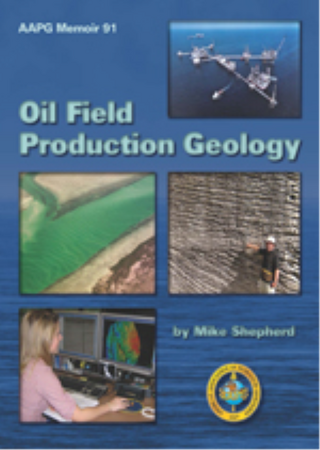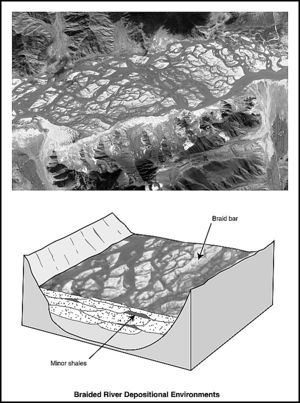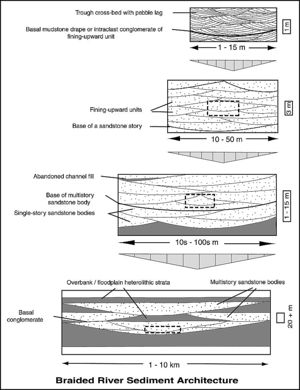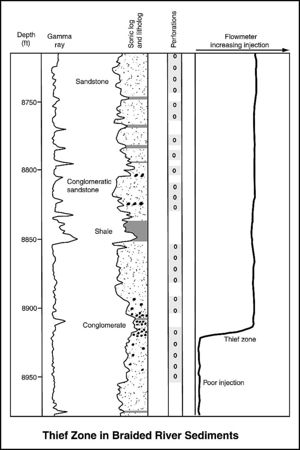Braided fluvial reservoirs
| Oil Field Production Geology | |

| |
| Series | Memoirs |
|---|---|
| Part | The Production Geologist and the Reservoir |
| Chapter | Braided fluvial reservoirs |
| Author | Mike Shepherd |
| Link | Web page |
| PDF file (requires access) | |
| Store | AAPG Store |

Braided fluvial systems
Sandy braided river systems show an intricate geometry of small bars, sand flats, and vegetated islands (Figure 1). The river flows across and between the various bars, splitting and joining continuously in a braided pattern.[2] Repeated avulsion generates a complex of amalgamated channel segments.
Braided fluvial sediments make good reservoirs
Braided river reservoirs typically make excellent, very productive reservoirs. The net to gross can be much higher than in meander-belt reservoirs, and there is normally much less in the way of interbedded shales. Braided river deposits can occur on a continental scale with individual systems that are very thick and laterally very extensive. Gibling[3] quoted widths in excess of 40 km (25 mi) and thicknesses up to 1200 m (3937 ft) for the very large braided river systems (Table 1). These form in response to periods of active tectonism, rapid subsidence, and a large volume of coarse sediment influx. These conditions are typical for foreland basins where braided fluvial sediments are commonly found.
| Depositional environment | Thickness | Width | Width/thickness ratio |
|---|---|---|---|
| Braided and low sinuousity rivers | 1-1200 m (3-3937 ft); most < 60 m (197 ft); common range 5-60 m (16-197 ft) | 50 m-1300+ km (164 ft-808+ mi); many > 1 km (0.62 mi); common range 0.5-10 km (0.3-6 mi) | 15-15,000+; some > 1000; common range 50-1000 |
| Meandering rivers | 1-38 m (3-125 ft); common range 4-20 m (13-65 ft) | 30 m-15 km (98 ft-9 mi); most < 3 km (1.8 mi); common range 0.3-3 km (0.1-1.8 mi) | 7-940; most < 250; many < 100; common range 30-250 |
| Delta distributaries | 1-35 m (3-115 ft); most < 20 m (65 ft); common range 3-20 m (10-65 ft) | 3 m-1 km (10 ft-0.6 mi); most < 500 m (1640 ft); common range 10-300 m (33-984 ft) | 2-245; most < 50; many < 15; common range 5-30 |
| Channels in eolian settings | 1-19 m (3-62 ft) | 2.5-1500 m (8.2-4921 ft); most < 150 m (492 ft) | 1-90; most < 15 |
| Valley fills on bedrock unconformities | 12-1400 m (39-4593 ft); most < 500 m (1640 ft) | 75 m-52 km (246 ft-32 mi); most < 10 km (6 mi) | 2-870; highly variable; mainly 2-100 |
| Valley fills within alluvial and marine strata | 2-210 m (6-689 ft); most < 60 m (197 ft) | 0.1-105 km (0.06-65 mi); common range 0.2-25 km (0.1-15 mi) | 4.6-3640; highly variable; common range 10-1000; many from 100 to 1000 |
| 1From Gibling[3], Journal of Sedimentary Research. Reprinted with permission from, and © by, the SEPM (Society for Sedimentary Geologists). | |||
Some very big oil fields are known from braided river reservoirs, including the Prudhoe Bay field in Alaska and several giant oil fields in the Sirte basin of Libya.
Lateral continuity
Lateral continuity is typically excellent in braided fluvial reservoirs. The net to gross of these systems is normally very high (>80%), and, as such, these types of reservoirs are usually well connected laterally. In detail, they can be internally complex with intervals of upward-decreasing permeability profiles, but the lack of organized stratification or laterally continuous shales results in braided fluvial reservoirs showing effectively layer-cake geometry and acting as a single integrated reservoir at the larger scale.[4]
Braided river systems normally comprise medium to coarse-grained sands and gravels, and the rock properties can be excellent. Oil recovery factors can be very high in braided river reservoirs, commonly more than 50%.[5] Laterally extensive braided river reservoirs tend to be in communication with strong aquifers.
Barriers to vertical flow
Not much mud is preserved in braided river systems under normal conditions. What mud there is, collects as bar tops or represents fragments of floodplain silts and muds. The shales tend not to be very extensive and are randomly distributed. Formation tester data in braided river reservoirs typically show good vertical pressure communication with only localized evidence for flow baffling.[5]
In some braided river sediments, shales are laterally more extensive and may be correlatable.[6][7] Where floodplain shales cover a large area, they can act as permeability barriers bounding hydraulic units. Widespread lacustrine shale beds act as barriers within the Jurassic braided river reservoir of the Jackson field of Australia[8] and in the Tertiary Merecure unit B interval of the Budare field in Venezuela.[9]

Robinson and McCabe[10] studied braided river sediments from the Morrison Formation of Utah. Individual single-story sand bodies have a mean width of 271 m (889 ft) and a mean thickness of 5 m (16 ft) in the lower interval. In the upper interval, the mean width is 530 m (1739 ft) with a mean thickness of 10 m (33 ft). Two types of shale-prone facies have the potential to form baffles to flow. Overbank or floodplain deposits are laterally extensive (mean width 305 m; 1000 ft) and have the potential to form barriers or baffles to vertical flow communication. Abandoned channel-fill deposits are shorter ranging with mean widths of 99 m (325 ft) (Figure 2).
Local shale barriers in the braided river deposits of the Prudhoe Bay field in Alaska are advantageous to production where they occur because they inhibit both gas coning and water influx to wells. Wells with shale barriers can be produced at higher than normal rates as a result.[11] However, in certain situations, they can be detrimental to production. Shales can act as baffles to pressure support from gas cap expansion to the producing intervals underneath them. Gas underrun can also be a problem.
In the Lower Cretaceous Cutbank Sandstone of Southern Alberta, channel lag deposits with clay-rich rip-up clasts have undergone later diagenetic modification. These form flow barriers within the braided river sediments.[12] Likewise, intraformational mudclast conglomerates were considered potential permeability barriers in ephemeral braided fluvial deposits of the Lower Jurassic Kayenta Formation of Utah.[13]

Permeability variation
Vertical permeability variation can be a significant feature in braided river reservoirs (Table 2). High permeabilities in the coarser pebbly layers are known to act as thief zones. An example of this is given by Atkinson et al.[11] from the Prudhoe Bay field, Alaska. One injection well shows 95% of the total injected water entering a 3-m (10-ft)-thick conglomeratic zone with a permeability of 4 darcies (Figure 3).
| Characteristic | Favorable for reservoir development | Unfavorable for reservoir development |
|---|---|---|
| High net-to-gross, thick sand units | High connectivity, commonly acting as a single hydraulic unit | - |
| Thick sand bodies, areally extensive, commonly on a continental scale | Typically have big aquifers with efficient water drive | - |
| Shales not commonly laterally extensive | Good vertical pressure communication where present shales can inhibit coning behavior | - |
| Floodplain and lacustrine shales can act as laterally extensive permeability barriers | - | Less effective vertical pressure communication |
| Cemented channel lag deposits can form permeability barriers | - | Less effective vertical pressure communication |
| Thief zones present in coarse-grained intervals | - | Poor sweep |
See also
- Eolian reservoirs
- Meandering fluvial reservoirs
- Deltaic reservoirs
- Siliciclastic shorelines and barrier island reservoirs
- Deep-water marine reservoirs
- Carbonate reservoir
References
- ↑ Cant, D. J., 1982, Fluvial facies models, in P. A. Scholle and D. R. Spearing, eds., Sandstone depositional environments: AAPG Memoir 31, p. 115–137.
- ↑ Walker, R. G., and D. J. Cant, 1984, Sandy fluvial systems, in R. G. Walker, ed., Facies models: Toronto, Canada, Geological Association of Canada, p. 71–89.
- ↑ 3.0 3.1 Gibling, M. R. 2006, Width and thickness of fluvial channel bodies and valley fills in the geological record: A literature compilation and classification: Journal of Sedimentary Research, v. 76, p. 731–770.
- ↑ Galloway, W. E., and D. K. Hobday, 1996, Terrigenous clastic depositional systems: Applications to petroleum, coal, and uranium exploration: New York, Springer-Verlag, 489 p.
- ↑ 5.0 5.1 Martin, J. H., 1993, A review of braided fluvial hydrocarbon reservoirs: The petroleum engineer's perspective, in J. L. Best and C. S. Bristow, eds., Braided rivers: Geological Society Special Publication 75, p. 333–367.
- ↑ Geehan, G. W., T. F. Lawton, S. Sakurai, H. Klob, T. R. Clifton, K. F. Inman, and K. E. Nitzberg, 1986, Geologic prediction of shale continuity, Prudhoe Bay field, in L. W. Lake and H. B. Carroll, eds., Reservoir characterization: Orlando, Florida, Academic Press, p. 63–82.
- ↑ Davies, D. K., B. P. J. Williams, and R. K. Vessell, 1993, Dimensions and quality of reservoirs originating in low and high sinuosity channel systems, Lower Cretaceous Travis Peak Formation, east Texas, U.S.A., in C. P. North and D. J. Prosser, eds., 1993, Characterization of fluvial and eolian reservoirs: Geological Society Special Publication 73, p. 95–121.
- ↑ Hamilton, D. S., M. H. Holtz, P. Ryles, T. Lonergan, and M. Hillyer, 1998, Approaches to identifying reservoir heterogeneity and reserve growth opportunities in a continental-scale bed-load fluvial system: Hutton sandstone, Jackson field, Australia: AAPG Bulletin, v. 82, no. 12, p. 2192–2219.
- ↑ Hamilton, D. S., et al., 2002, Reactivation of mature oil fields through advanced reservoir characterization: A case history of the Budare field, Venezuela: AAPG Bulletin, v. 86, no. 7, p. 1237–1262.
- ↑ 10.0 10.1 Robinson, J. W., and P. J. McCabe, 1997, Sandstone-body and shale-body dimensions in a braided fluvial system: Salt Wash Sandstone Member (Morrison Formation), Garfield County, Utah: AAPG Bulletin, v. 81, no. 8, p. 1267–1291.
- ↑ 11.0 11.1 11.2 Atkinson, C. D., J. H. McGowen, S. Bloch, L. L. Lundell, and P. N. Trumbly, 1990, Braidplain and deltaic reservoir, Prudhoe Bay field, Alaska, in J. H. Barwis, J. G. McPherson, and R. J. Studlick, eds., Sandstone petroleum reservoirs: Berlin, Springer-Verlag, p. 7–29.
- ↑ Farshori, M. S., and J. C. Hopkins, 1989, Sedimentology and petroleum geology of fluvial and shoreline deposits of the Lower Cretaceous Sunburst Sandstone Member, Mannville Group, southern Alberta: Bulletin of Canadian Petroleum Geology, v. 37, p. 371-388.
- ↑ North, C. P., and K. S. Taylor, 1996, Ephemeral-fluvial deposits: integrated outcrop and simulation studies reveal complexity: AAPG Bulletin, v. 80, no. 6, p. 811–830.